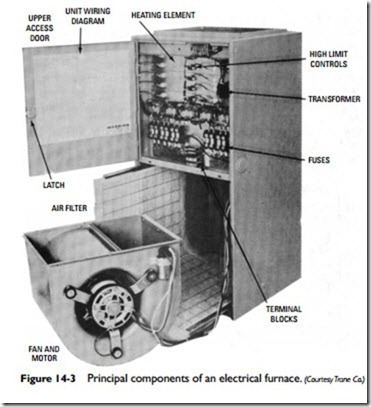Installation Recommendations
New electric furnaces for residential installation are shipped from the factory with all internal wiring completed. These furnaces are also generally shipped as a preassembled unit. In order to install the new furnace, the electric service from the line voltage main and the low-voltage thermostat must be connected. Directions for making these connections are found in the furnace manufacturer’s installation instructions.
Familiarize yourself with all local codes and regulations that govern the installation of an electric furnace. Local codes and regulations take precedence over national standards.
Check the insulation of the structure to determine whether it is properly insulated for electric heat. The insulation should be installed in accordance with recommendations in All Weather Comfort Standard of Electrically Heated and Air Conditioned Homes (Electric Heating Association).
The furnace should be mounted on a level surface. If the unit is not level, it may develop serious vibrations. An insulating material can be placed under the furnace in most installations to reduce sound vibrations when the unit is operating. A noncombustible base is recommended for counterflow models.
Duct Connections
Detailed information concerning the installation of an air-duct sys-
tem is contained in the following two publications of the National Fire Protection Association:
1. Installation of Air Conditioning and Ventilating Systems of Other Than Residence Type (NFPA No. 90A).
2. Residence Type Warm Air Heating and Air Conditioning Systems (NFPA No. 90B).
Additional information about duct connections can be found in Chapter 7, “Ducts and Duct Systems” of Volume 2. The comments made in Chapter 11, “Gas Furnaces” about furnace duct connections and air distribution ducts apply for the most part to ducts used with electric forced-warm-air furnaces.
Basic Components
An electric forced-warm-air furnace will generally consist of the fol- lowing basic components (Figure 14-3):
1. Automatic controls
2. Heating elements
3. Safety controls
4. Blowers and motors
5. Air filter(s)
Some electric furnaces also include an electronic air cleaner, an air conditioning evaporator coil, a humidifier, or some combination of these accessories. An electric heating/cooling system may also include a condensate pump if the dehumidifying process produces excessive amounts of water. In a zoned electric heating system, a zone control panel and motor-actuated dampers will be attached to either the furnace or the ducts.
Each of these components is described in the sections that fol- low. Additional information is contained in Chapter 10, “Furnace Fundamentals” and the various chapters in which furnace controls are described.
